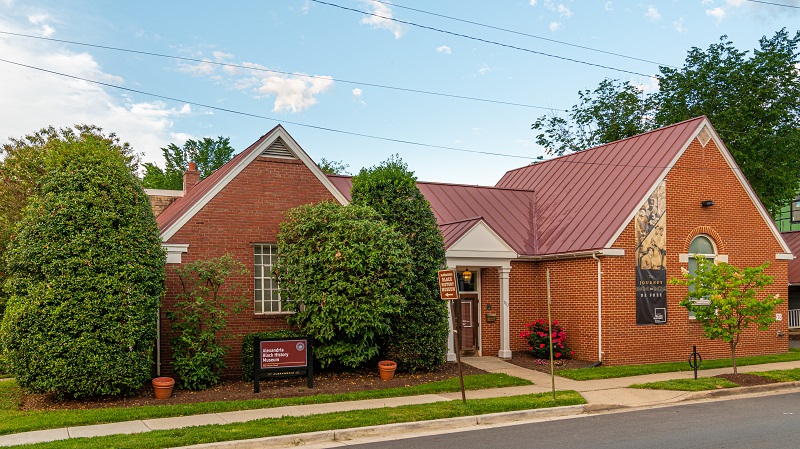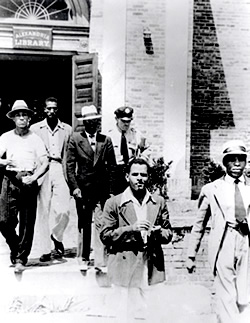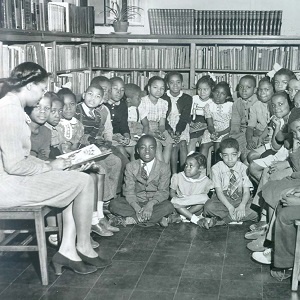
History of the Alexandria Black History Museum
History of the Alexandria Black History Museum

The Alexandria Black History Museum (ABHM) is located in the Parker-Gray Historic District of the City. This district is named in honor of the Parker-Gray School, the only high school African American students could attend in Alexandria until 1965.
In 1983, through the advocacy of the Parker-Gray Alumni and the Alexandria Society for the Preservation of Black Heritage, the Robert H. Robinson Library re-opened as the Black Alexandria & Parker Gray Alumni Historic Resource Center (later Alexandria Black History Resource Center and then Alexandria Black History Museum). At first, staffing was provided on a volunteer basis by the members of these organizations.
In 1987, the Alexandria City Council placed the operation of the Museum under the Office of Historic Alexandria and provided funding for an addition to the building that was completed in 1989.
The Museum has grown dramatically since 1989. In June 1995, two additional sites were added to the Museum: the Alexandria African American Heritage Park and the Watson Reading Room. The nine-acre park, which is located several blocks away from the Museum, preserves the site of a 19th-century African American cemetery. The non-circulating reading room, which was built next door to the ABHM, houses books and periodicals on African American life, history, and culture.
The Museum follows its mission to enrich the lives of Alexandria’s residents and visitors, to foster tolerance and understanding, and to stimulate appreciation for the diversity of the African American experience. The Museum uses its large collection to inspire the public to explore the integral relationship between African American history and other cultural traditions. With one permanent and one rotating exhibition gallery, as well as a variety of programs and lectures, the Alexandria Black History Museum continues to expand educational opportunities for residents, scholars, and tourists.
The Sit-Down Strike and the Robinson Library

An important event in 20th-century Alexandria’s African American history occurred in 1939. This event raised the consciousness of the minority community and became one of the watershed moments in Alexandria’s civil rights history.
On August 21, 1939, lawyer Samuel W. Tucker sent five young African American men to stage a peaceful protest at the whites-only library at 717 Queen Street in Alexandria, VA. The five men were arrested for disorderly conduct, but the charges against the men were dropped. In September, the court heard Tucker’s petition and agreed that African Americans should have access to a library. In 1940, the Robert H. Robinson Library was constructed for the African American citizens of Alexandria.
This segregated library was used until desegregation in the early 1960s. After desegregation, the building was used for various community service programs. Today, the Robert H. Robinson Library forms an integral part of the Alexandria Black History Museum.
The Alexandria Circuit Court dismissed all charges against the sit-in participants on October 18, 2019. Although the five African American residents were charged with disorderly conduct, the Court found that they were “lawfully exercising their constitutional rights to free assembly, speech and to petition the government to alter the established policy of sanctioned segregation at the time of their arrest,” and that “sitting peacefully in a library reading books … was not in any fashion disorderly or likely to cause acts of violence.”
The Robert H. Robinson Library

Dr. Brenda Mitchell-Powell, for the Alexandria Black History Museum
Robert H. Robinson Library opened less than a year after the August 21, 1939, Alexandria Library sit-in and less than four months from Judge William Pape Woolls’ ruling on the writ of mandamus filed by Samuel Wilbert Tucker on behalf of Sergeant George Wilson. Acting as Sergeant Wilson’s attorney, Tucker had completed Sergeant Wilson’s application for library privileges at the Alexandria Library. Judge Woolls ruled that if Sergeant Wilson had completed the library application himself and provided proof of his residence in Alexandria, Katharine Scoggins, the Alexandria Library Librarian, would have been obliged to grant his request for a library card. This ruling shocked the Alexandria Library Board of Directors and the City Council members. They realized the decision would open the doors of the library to African American Alexandrians. In fact, within two days of the court ruling, two African Americans applied for library cards. Dorothy Pierce was the first applicant.
The Alexandria Library Board of Directors and the City Council rushed to construct a separate and unequal branch library for the city’s African American citizens to circumvent integration of the whites-only Alexandria Library. City Council named the library in honor of Robert H. Robinson, a Methodist minister and formerly enslaved man. He was also the grandson of Caroline Branham, Martha Washington’s personal maid. Ward Brown, the architect for the structure, designed a one-room Colonial-style brick building on the corner of Wythe and North Alfred streets in Old Town Alexandria. The total costs for the new branch included $2,500 for construction expenses, $750 for the purchase of the site, $1,941.50 for books and equipment, and $1,750 for annual operating costs — considerably less than the cost to build, stock, and maintain the city’s white library.
The Robert H. Robinson Library opened for patron inspection on April 23, 1940. The next day the library was open for patrons to register for library cards. The first full-time Librarian was Evelyn Roper Beam, a highly qualified African American woman with superb credentials. Nevertheless, she was paid only $720.00 per year. By contrast, Ellen Coolidge Burke, the white, part-time Alexandria Library Assistant Librarian and Cataloger was paid $1,940.00 per year.
The first collection of books at the Robinson Library totaled approximately 1,500 volumes. Most were castoffs from the Alexandria Library or donated used books. Only a few new books were purchased for the library. Robinson Library patrons also had borrowing privileges from the Alexandria Library, but they were not allowed into the whites-only library to acquire books themselves. Instead, their selections had to be retrieved for them and returned to the main library by Miss Beam. To serve their research needs, they could borrow reference books overnight, but these, too, had to be retrieved and returned by Miss Beam.
Most Robinson Library patrons were elementary school and high school students who used the library’s resources to compete their schoolwork. In addition to providing assistance with class assignments, the Robinson Library offered story hours and activities for children. Adults were also library card holders, participated in a reading club and using the space for community meetings and social events.
The Robinson Library continued to serve the needs of African American Alexandrians, despite acknowledged, overcrowded conditions, until February 1959. That winter the Alexandria Library quietly integrated for African American adults and high school students. Children continued to be served by the Robinson Library until July 1962 when the Alexandria Library was fully integrated. From 1962 until 1969, the Robinson Library served as the city’s Bookmobile Station. In 1983, the building was repurposed as the Alexandria Black History Resource Center. It underwent a complete renovation from 1988 to 1989. In 2004, the Black History Resource Center was renamed the Alexandria Black History Museum.